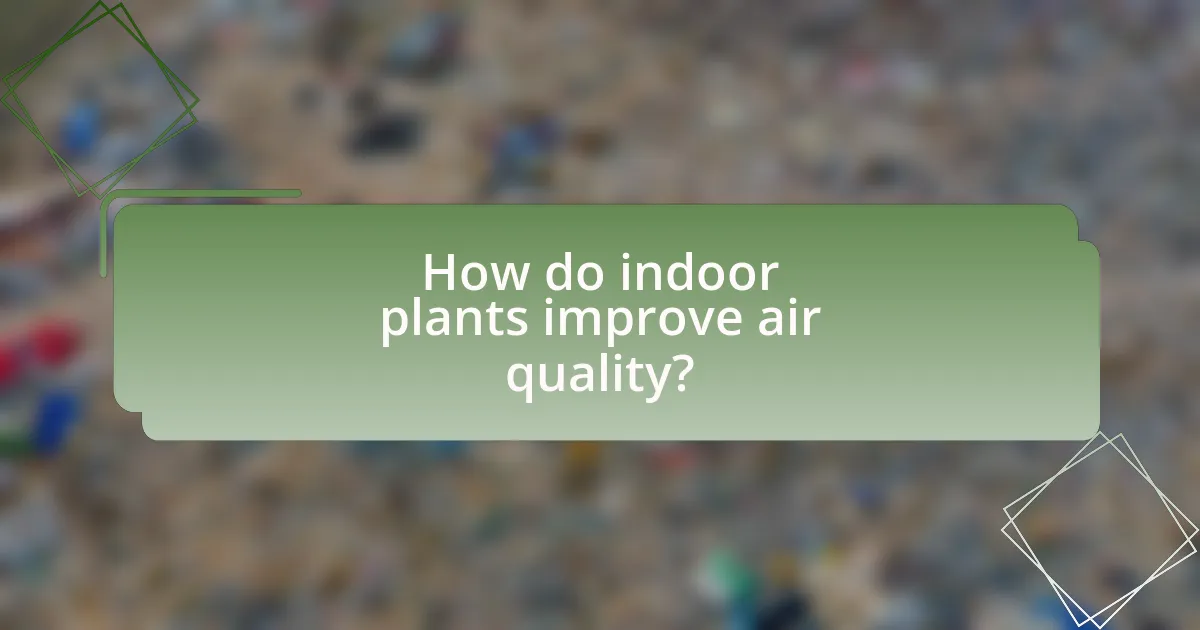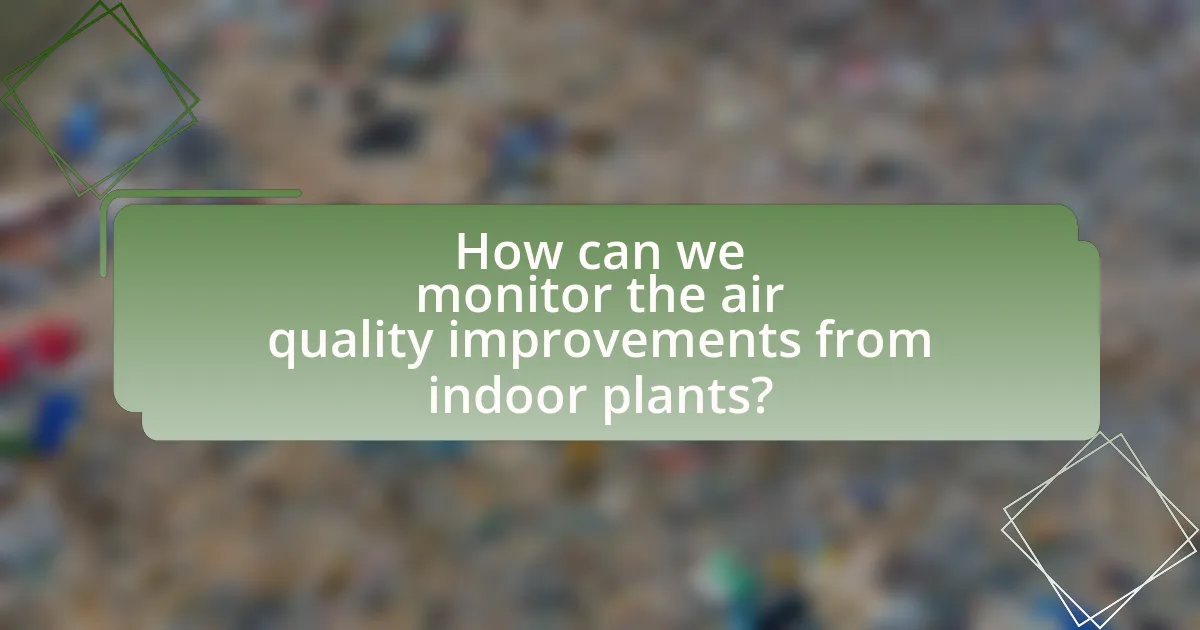Indoor plants play a crucial role in improving air quality by absorbing carbon dioxide and releasing oxygen through photosynthesis, while also filtering harmful pollutants such as formaldehyde, benzene, and trichloroethylene. Research, notably from NASA, highlights the effectiveness of specific plants like the peace lily and spider plant in significantly reducing indoor air toxins. The article explores the types of pollutants that indoor plants can filter, their impact on carbon dioxide levels, and the importance of maintaining good air quality for human health. Additionally, it discusses practical considerations for selecting and caring for indoor plants, as well as methods for monitoring air quality improvements over time.
How do indoor plants improve air quality?

Indoor plants improve air quality by absorbing carbon dioxide and releasing oxygen through photosynthesis. This process not only increases oxygen levels but also helps to filter out harmful pollutants such as formaldehyde, benzene, and trichloroethylene. Research conducted by NASA in the late 1980s demonstrated that certain indoor plants, like the peace lily and spider plant, can effectively remove these toxins from the air, thereby enhancing indoor air quality. Additionally, plants can increase humidity levels through transpiration, which can further reduce airborne dust and improve overall comfort in indoor environments.
What specific pollutants can indoor plants filter from the air?
Indoor plants can filter specific pollutants from the air, including volatile organic compounds (VOCs) such as formaldehyde, benzene, and trichloroethylene. Research conducted by NASA in the late 1980s demonstrated that certain houseplants, like the spider plant and peace lily, effectively reduce these harmful substances, improving indoor air quality. The study found that formaldehyde levels could be reduced by up to 90% in a sealed environment with adequate plant coverage, showcasing the significant air-purifying capabilities of indoor plants.
How effective are indoor plants in removing volatile organic compounds (VOCs)?
Indoor plants are effective in removing volatile organic compounds (VOCs) from indoor air. Research conducted by NASA in the late 1980s demonstrated that certain houseplants, such as the Peace Lily and Spider Plant, can significantly reduce VOC levels, with some studies indicating up to 87% reduction in 24 hours. This effectiveness is attributed to the plants’ ability to absorb these compounds through their leaves and roots, as well as the microbial activity in the soil that further breaks down VOCs.
What role do indoor plants play in reducing carbon dioxide levels?
Indoor plants play a significant role in reducing carbon dioxide levels through the process of photosynthesis. During photosynthesis, plants absorb carbon dioxide from the air and convert it into oxygen, effectively lowering the concentration of carbon dioxide indoors. Research indicates that certain indoor plants, such as the peace lily and spider plant, can remove up to 87% of indoor air pollutants, including carbon dioxide, within 24 hours. This ability to improve air quality is particularly beneficial in enclosed spaces where ventilation may be limited, thus enhancing overall indoor environmental health.
Why is air quality important for indoor environments?
Air quality is crucial for indoor environments because it directly impacts human health, comfort, and productivity. Poor air quality can lead to respiratory issues, allergies, and other health problems, as evidenced by studies showing that indoor air can be up to five times more polluted than outdoor air. Maintaining good air quality is essential for reducing the risk of these health issues and enhancing overall well-being.
How does poor air quality affect human health?
Poor air quality negatively impacts human health by increasing the risk of respiratory diseases, cardiovascular issues, and other health problems. Exposure to pollutants such as particulate matter, nitrogen dioxide, and sulfur dioxide can lead to conditions like asthma, chronic obstructive pulmonary disease (COPD), and heart attacks. According to the World Health Organization, air pollution is responsible for approximately 7 million premature deaths annually, highlighting its severe effects on public health.
What are the long-term effects of indoor air pollution?
Long-term effects of indoor air pollution include respiratory diseases, cardiovascular issues, and cognitive impairments. Prolonged exposure to pollutants such as volatile organic compounds (VOCs), particulate matter, and carbon monoxide can lead to chronic conditions like asthma and lung cancer. According to the World Health Organization, indoor air pollution is responsible for approximately 3.8 million premature deaths annually, highlighting its severe health impacts. Additionally, studies indicate that long-term exposure can affect mental health, leading to increased anxiety and depression.
What types of indoor plants are best for improving air quality?
Spider plants, peace lilies, and snake plants are among the best indoor plants for improving air quality. These plants are known for their ability to filter common indoor pollutants such as formaldehyde, benzene, and carbon monoxide. Research conducted by NASA in the late 1980s demonstrated that these plants can significantly reduce indoor air toxins, making them effective choices for enhancing air quality in homes and offices.
Which plants are most effective at purifying the air?
The most effective plants at purifying the air include the Spider Plant, Snake Plant, Peace Lily, and Boston Fern. Research conducted by NASA in the Clean Air Study identified these plants as capable of removing common indoor pollutants such as formaldehyde, benzene, and trichloroethylene. For instance, the Peace Lily can remove up to 60% of these toxins within 24 hours, demonstrating its significant air-purifying capabilities.
How do different plants compare in their air-cleaning abilities?
Different plants exhibit varying air-cleaning abilities, with some being significantly more effective than others. For instance, studies have shown that the Peace Lily can remove up to 60% of indoor air pollutants like formaldehyde and benzene within 24 hours, while the Spider Plant is also effective, removing about 90% of pollutants over a longer period. Research conducted by NASA in the late 1980s highlighted the air-purifying capabilities of several plants, ranking them based on their ability to filter volatile organic compounds. This research established that plants such as the Boston Fern and the Rubber Plant are particularly efficient in improving indoor air quality.
How can we monitor the air quality improvements from indoor plants?

To monitor air quality improvements from indoor plants, utilize air quality sensors that measure pollutants such as carbon dioxide, volatile organic compounds (VOCs), and particulate matter. These sensors provide quantitative data on air quality levels before and after introducing indoor plants. Studies, such as one published in the Journal of Environmental Horticulture, demonstrate that specific plants can reduce indoor air pollutants by up to 87% within 24 hours, validating the effectiveness of monitoring methods. Regularly recording sensor data allows for a clear comparison of air quality metrics, establishing a direct correlation between the presence of indoor plants and improvements in air quality.
What methods are available for monitoring indoor air quality?
Methods for monitoring indoor air quality include the use of electronic sensors, passive sampling devices, and laboratory analysis. Electronic sensors provide real-time data on pollutants such as carbon dioxide, volatile organic compounds, and particulate matter, allowing for immediate assessment of air quality. Passive sampling devices, which absorb air pollutants over time, can be analyzed later in a laboratory to determine average concentrations of specific contaminants. Laboratory analysis can also involve collecting air samples for detailed chemical composition analysis, providing comprehensive insights into indoor air quality. These methods are validated by studies showing their effectiveness in detecting and quantifying indoor air pollutants, thus ensuring accurate monitoring of air quality conditions.
How do air quality sensors work in measuring pollutants?
Air quality sensors measure pollutants by detecting specific gases and particulate matter in the air using various technologies. These sensors typically employ methods such as electrochemical detection, infrared spectroscopy, or laser scattering to identify and quantify pollutants like carbon dioxide, volatile organic compounds, and particulate matter. For instance, electrochemical sensors generate a current proportional to the concentration of a target gas, while infrared sensors measure the absorption of infrared light by gas molecules, providing accurate readings of pollutant levels.
What are the best practices for using air quality monitors?
The best practices for using air quality monitors include placing them in areas with good air circulation, regularly calibrating the devices, and interpreting the data in context. Proper placement ensures accurate readings, as monitors should be positioned away from walls and obstructions to capture representative air samples. Regular calibration is essential to maintain accuracy, as environmental factors can affect sensor performance over time. Additionally, understanding the data requires considering factors such as time of day and weather conditions, which can influence air quality readings. Following these practices enhances the reliability of air quality monitoring, ultimately aiding in effective air quality management.
How can we assess the impact of indoor plants on air quality over time?
To assess the impact of indoor plants on air quality over time, researchers can conduct controlled experiments that measure specific air quality indicators, such as levels of volatile organic compounds (VOCs), carbon dioxide, and particulate matter before and after introducing plants into a space. Studies, such as those conducted by NASA in the late 1980s, demonstrated that certain indoor plants can significantly reduce VOC levels, indicating their effectiveness in improving air quality. Continuous monitoring using air quality sensors can provide quantitative data over time, allowing for the analysis of trends and the long-term benefits of maintaining indoor plants in various environments.
What metrics should be tracked to evaluate air quality changes?
To evaluate air quality changes, metrics such as particulate matter (PM2.5 and PM10), volatile organic compounds (VOCs), carbon dioxide (CO2) levels, nitrogen dioxide (NO2), ozone (O3), and humidity should be tracked. Particulate matter measurements indicate the presence of harmful particles in the air, while VOCs are associated with indoor pollution sources. CO2 levels reflect ventilation effectiveness, and NO2 and O3 are critical for assessing outdoor air quality impacts. Humidity levels can influence the effectiveness of indoor plants in improving air quality, as they affect plant transpiration and pollutant absorption. Tracking these metrics provides a comprehensive understanding of air quality dynamics and the potential benefits of indoor plants in mitigating pollution.
How often should air quality be monitored to see significant changes?
Air quality should be monitored at least once a week to detect significant changes. Regular weekly monitoring allows for the identification of trends and fluctuations in air quality, which can be influenced by various factors such as indoor plant growth, seasonal changes, and human activities. Studies indicate that pollutants can vary significantly over short periods, making weekly assessments crucial for understanding air quality dynamics and implementing effective interventions.
What are the practical considerations for using indoor plants to improve air quality?

Using indoor plants to improve air quality involves several practical considerations, including plant selection, placement, maintenance, and environmental factors. Selecting plants known for their air-purifying abilities, such as spider plants, peace lilies, and snake plants, is essential, as studies have shown these species can effectively remove toxins like formaldehyde and benzene from indoor air. Placement is crucial; plants should be positioned in areas with adequate light and airflow to maximize their growth and air-cleaning potential. Regular maintenance, including watering, pruning, and repotting, ensures plants remain healthy and effective in improving air quality. Additionally, environmental factors such as humidity and temperature can influence plant performance, as optimal conditions enhance their ability to filter air pollutants.
How can one effectively incorporate indoor plants into their living space?
To effectively incorporate indoor plants into living spaces, one should select plants that thrive in the specific light conditions of the area, such as snake plants for low light or succulents for bright light. Positioning these plants strategically can enhance aesthetics and improve air quality, as studies show that certain indoor plants can remove toxins like formaldehyde and benzene from the air. For instance, a NASA study identified that plants like peace lilies and spider plants significantly reduce indoor air pollutants, making them ideal choices for homes. Regular maintenance, including appropriate watering and pruning, ensures the plants remain healthy and continue to provide their air-purifying benefits.
What factors should be considered when choosing plants for air quality improvement?
When choosing plants for air quality improvement, factors such as the plant’s ability to remove specific pollutants, its growth requirements, and its maintenance needs should be considered. Certain plants, like the spider plant and peace lily, have been shown to effectively remove toxins such as formaldehyde and benzene from indoor air, as evidenced by research conducted by NASA in the Clean Air Study. Additionally, understanding the light and humidity requirements of these plants ensures they thrive in indoor environments, which is crucial for their air-purifying capabilities. Lastly, the maintenance level required for each plant, including watering frequency and susceptibility to pests, impacts their long-term effectiveness in improving air quality.
How can plant placement affect their air-purifying capabilities?
Plant placement significantly influences their air-purifying capabilities by determining the exposure to light, airflow, and proximity to pollutants. For instance, placing plants in well-lit areas enhances their photosynthesis, which increases their ability to absorb carbon dioxide and release oxygen, thereby improving air quality. Additionally, positioning plants near sources of indoor pollutants, such as electronic devices or cooking areas, allows them to more effectively filter out harmful substances like formaldehyde and benzene. Research indicates that certain plants, such as the spider plant and peace lily, are particularly effective in removing toxins when strategically placed in high-traffic areas of a room.
What maintenance practices are essential for indoor plants to thrive?
Essential maintenance practices for indoor plants to thrive include proper watering, adequate light exposure, appropriate humidity levels, regular fertilization, and pest management. Proper watering ensures that plants receive the right amount of moisture without becoming waterlogged, which can lead to root rot. Adequate light exposure is crucial, as different plants have varying light requirements; for instance, succulents thrive in bright light, while ferns prefer indirect light. Maintaining appropriate humidity levels, typically between 40-60%, supports plant health, especially for tropical species. Regular fertilization, using a balanced fertilizer during the growing season, provides essential nutrients that promote growth. Lastly, effective pest management, including regular inspections and the use of insecticidal soap when necessary, helps prevent infestations that can harm plants. These practices collectively contribute to the overall health and vitality of indoor plants, enhancing their ability to improve air quality.
How often should indoor plants be watered and fertilized?
Indoor plants should generally be watered every 1 to 2 weeks, depending on the plant species and environmental conditions. Fertilization typically occurs every 4 to 6 weeks during the growing season, which is usually spring and summer. These guidelines are based on the moisture needs of various indoor plants and their growth cycles, ensuring optimal health and air quality improvement.
What common issues should be monitored to ensure plant health?
Common issues that should be monitored to ensure plant health include pests, diseases, nutrient deficiencies, and environmental conditions such as light, humidity, and temperature. Pests like aphids and spider mites can damage plants, while diseases such as root rot can lead to plant decline. Nutrient deficiencies, particularly in nitrogen, phosphorus, and potassium, can affect growth and vitality. Additionally, monitoring environmental conditions is crucial, as inadequate light can stunt growth, low humidity can cause leaf drop, and extreme temperatures can stress plants. Regular observation and timely intervention can prevent these issues, promoting healthier indoor plants that contribute positively to air quality.
What tips can help maximize the air quality benefits of indoor plants?
To maximize the air quality benefits of indoor plants, select a variety of species known for their air-purifying properties, such as spider plants, peace lilies, and snake plants. These plants can effectively remove toxins like formaldehyde and benzene from the air, as demonstrated in a study by NASA, which identified specific plants that improve indoor air quality. Additionally, placing multiple plants in a well-ventilated area enhances their ability to filter air, as increased foliage allows for greater absorption of pollutants. Regular maintenance, including watering and dusting leaves, ensures optimal photosynthesis and air purification efficiency.

Leave a Reply